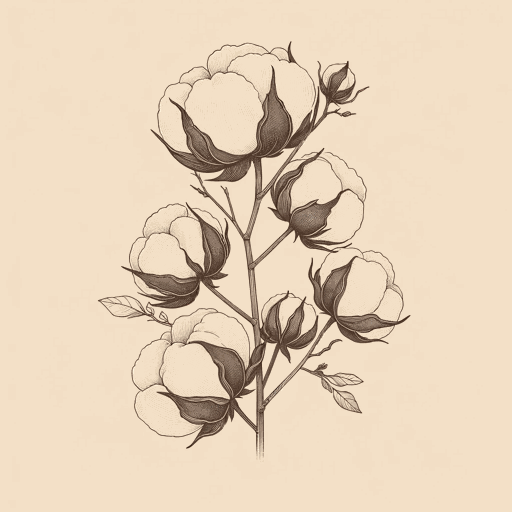61 pages • 2 hours read
Sven BeckertEmpire of Cotton
Nonfiction | Book | Adult | Published in 2014A modern alternative to SparkNotes and CliffsNotes, SuperSummary offers high-quality Study Guides with detailed chapter summaries and analysis of major themes, characters, and more.
Summary and Study Guide
Overview
Empire of Cotton is a nonfiction book published in 2014 by the German-American author and historian Sven Beckert. By chronicling the history of the global cotton trade and its vast network of growers, merchants, and manufacturers, the book explores the origins and evolution of modern capitalism. In a narrative spanning over two centuries, Beckett takes readers through the dawn of the Industrial Revolution, the American Civil War, and the collapse of colonialism following World War II—events all deeply-rooted in the world of cotton. For Empire of Cotton, Beckert won the Bancroft Prize and became a finalist for the Pulitzer Prize in History.
Beckert’s story begins in 1784 in Quarry Bank Mill, England. Samuel Greg, using a family fortune amassed over decades working in the West Indian slave trade, built a water-driven, yarn-spinning factory—a fitting microcosm of the cotton industry at this time. Almost all the major players in the industry made their fortunes trafficking humans in the slave trade, extracting most of its human capital from islands in the West Indies, such as Dominica. The abolition of slavery on British soil did little to curb the nation’s participation in the broader international slave trade. For example, even though the British were no longer buying slaves for their own use, they still took land from indigenous people around the world, making it easier for American slave traders to capture the residents of these areas. Furthermore, England—like most developed nations at the time—relied on cotton-based textiles farmed by slaves on American soil.
While Britain effectively exported slave labor to the Americas, the workers in its domestic cotton mills—while less subject to outright violence or coercion than slaves—operated under brutal conditions and threat of corporal punishment. These factories relied heavily on child labor and frequently utilized predatory contracts imposing criminal penalties on workers who wished to leave. Because the rise of cotton industrialization put most independent spinners and weavers out of business, these workers had little choice but to submit to the hot, tedious, and dangerous work found in what English poet William Blake described as “satanic mills.”
In 1861, the onset of the American Civil War sent the global cotton trade into a state of chaos, cutting off the crucial supply of American cotton into Britain. While British statesmen and industrialists long struggled to gain a decisive stranglehold over the supply of raw cotton in India, the Civil War compelled them to embark on an ambitious project to finally recast the Indian countryside in their favor. Through a complicated system of credit, coercion, and colonial infrastructure, Britain successfully compelled India’s cotton farming population to produce enough raw cotton for export to supply Europe’s burgeoning system of mills. This came at the expense of Indian farmers’ food crops, and millions would starve in the late 19th century and early 20th century as a result.
Having witnessed great strides being made in mobilizing non-slave labor in India, cotton industrialists looked to mobilize freedmen in America after the end of the Civil War in 1865. This posed several challenges, not least of which the fact that freed slaves had little appetite to return to cotton plantations, even if they did so in exchange for wages or a share of the crop proceeds. In the wake of President Andrew Johnson’s lenient Reconstruction policies, along with several coercive vagrancy laws and widespread lynching in the Southern states, many freedmen saw little choice but to return to plantation work with a quality of life only marginally above what they endured as slaves.
Throughout the first half of the 20th century, the world of cotton manufacturing, once dominated by Western Europe and the Northeastern United States, shifted again to Asia, India, and South America—the same locales that dominated the spinning and weaving industries prior to the Industrial Revolution. This reversal came about in large part due to the increasing demands for higher wages and fewer hours by laborers in Europe and the United States. These developments dovetailed with an explosion of anti-colonial movements in India, Egypt, and elsewhere that further loosened Great Britain’s grip on its greatest sources of raw cotton. By 1963, Britain’s reign over the empire of cotton was effectively at an end, its annual cotton cloth exports making up only 2.6 percent of the global total.
The book ends by examining the state of the cotton industry in the 2010s. As they did prior to the Industrial Revolution, China and India once again lead the way in raw cotton exports, displacing the United States, which only remains competitive in the global export market thanks to massive federal subsidies to domestic cotton farmers. Meanwhile, the new giants of the global cotton empire are not powerful nation-states but rather multinational retailers like Walmart, which amass huge profits by dominating commodity chains and selling inexpensive consumer goods manufactured by underpaid and overworked laborers concentrated mostly in Asia. While outright coercion and violence are less common in the cotton industry of the 21st century, the industry still relies on workers who don’t enjoy the benefits of labor laws that many in the West have come to take for granted.

